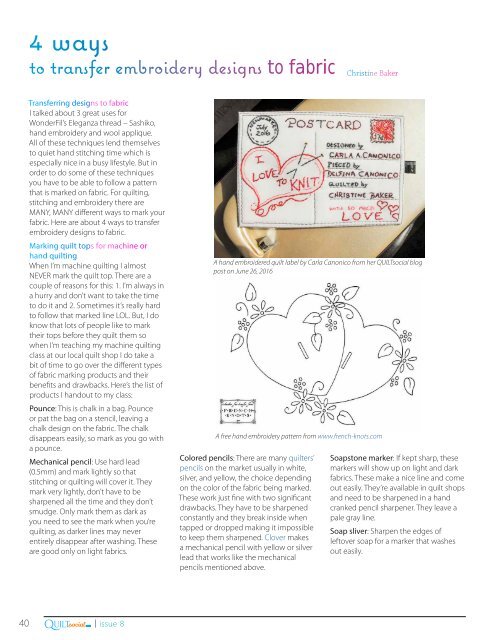QUILTsocial | Issue 08
Here it is, the new issue of QUILTsocial Magazine! We're extremely excited to release this FREE issue featuring a full 88 pages packed with free tutorials, patterns, and product reviews. This is a very exciting issue! (I know, I say that about all of them...) But I'm very excited that we're taking a close look at 3 different sewing machine brands, highlighting their special features and exploring them with cool projects. This issue also has the very fun and diverse quilting projects you've come to expect from QUILTsocial. You don't want to miss our many tutorials, like reducing bulk in your seams, threads that enhance Sashiko work, and bringing together stenciling fabric and machine embroidery to create a one of kind quilt block, to name a few. Enjoy the issue, and happy quilting!
Here it is, the new issue of QUILTsocial Magazine! We're extremely excited to release this FREE issue featuring a full 88 pages packed with free tutorials, patterns, and product reviews.
This is a very exciting issue! (I know, I say that about all of them...) But I'm very excited that we're taking a close look at 3 different sewing machine brands, highlighting their special features and exploring them with cool projects.
This issue also has the very fun and diverse quilting projects you've come to expect from QUILTsocial. You don't want to miss our many tutorials, like reducing bulk in your seams, threads that enhance Sashiko work, and bringing together stenciling fabric and machine embroidery to create a one of kind quilt block, to name a few. Enjoy the issue, and happy quilting!
Create successful ePaper yourself
Turn your PDF publications into a flip-book with our unique Google optimized e-Paper software.
4 ways<br />
to transfer embroidery designs to fabric<br />
Christine Baker<br />
Transferring designs to fabric<br />
I talked about 3 great uses for<br />
WonderFil’s Eleganza thread – Sashiko,<br />
hand embroidery and wool applique.<br />
All of these techniques lend themselves<br />
to quiet hand stitching time which is<br />
especially nice in a busy lifestyle. But in<br />
order to do some of these techniques<br />
you have to be able to follow a pattern<br />
that is marked on fabric. For quilting,<br />
stitching and embroidery there are<br />
MANY, MANY different ways to mark your<br />
fabric. Here are about 4 ways to transfer<br />
embroidery designs to fabric.<br />
Marking quilt tops for machine or<br />
hand quilting<br />
When I’m machine quilting I almost<br />
NEVER mark the quilt top. There are a<br />
couple of reasons for this: 1. I’m always in<br />
a hurry and don’t want to take the time<br />
to do it and 2. Sometimes it’s really hard<br />
to follow that marked line LOL. But, I do<br />
know that lots of people like to mark<br />
their tops before they quilt them so<br />
when I’m teaching my machine quilting<br />
class at our local quilt shop I do take a<br />
bit of time to go over the different types<br />
of fabric marking products and their<br />
benefits and drawbacks. Here’s the list of<br />
products I handout to my class:<br />
Pounce: This is chalk in a bag. Pounce<br />
or pat the bag on a stencil, leaving a<br />
chalk design on the fabric. The chalk<br />
disappears easily, so mark as you go with<br />
a pounce.<br />
Mechanical pencil: Use hard lead<br />
(0.5mm) and mark lightly so that<br />
stitching or quilting will cover it. They<br />
mark very lightly, don’t have to be<br />
sharpened all the time and they don’t<br />
smudge. Only mark them as dark as<br />
you need to see the mark when you’re<br />
quilting, as darker lines may never<br />
entirely disappear after washing. These<br />
are good only on light fabrics.<br />
A hand embroidered quilt label by Carla Canonico from her <strong>QUILTsocial</strong> blog<br />
post on June 26, 2016<br />
A free hand embroidery pattern from www.french-knots.com<br />
Colored pencils: There are many quilters’<br />
pencils on the market usually in white,<br />
silver, and yellow, the choice depending<br />
on the color of the fabric being marked.<br />
These work just fine with two significant<br />
drawbacks. They have to be sharpened<br />
constantly and they break inside when<br />
tapped or dropped making it impossible<br />
to keep them sharpened. Clover makes<br />
a mechanical pencil with yellow or silver<br />
lead that works like the mechanical<br />
pencils mentioned above.<br />
Soapstone marker: If kept sharp, these<br />
markers will show up on light and dark<br />
fabrics. These make a nice line and come<br />
out easily. They’re available in quilt shops<br />
and need to be sharpened in a hand<br />
cranked pencil sharpener. They leave a<br />
pale gray line.<br />
Soap sliver: Sharpen the edges of<br />
leftover soap for a marker that washes<br />
out easily.<br />
Q<br />
40 .com | issue 8<br />
UILTsocial

















